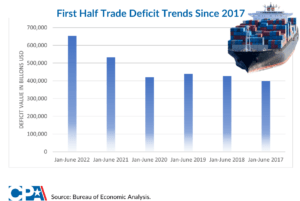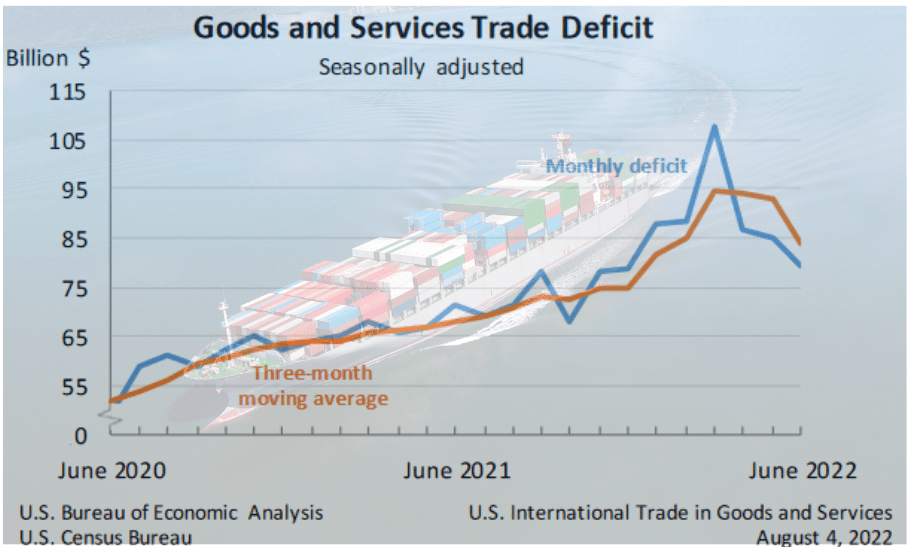The June deficit in the goods and services trade declined by 6.2% to $79.6 billion, signaling a tapping of the brakes of the U.S. economy as a recession looms ahead.
With the data for the first half of 2022 complete, our trade deficit of $535.0 billion is running 33.4% worse than last year’s first half figure. On a goods-only basis, our first half deficit of $654.0 billion is 22.8% worse than last year. According to CPA Chief Economist Jeff Ferry, both data points show another record-high deficit is on par for this year. Realistic estimates are that the total deficit could hit $1 trillion while the goods deficit could reach $1.3 trillion. Last year’s goods deficit was $1.09 trillion.
“We still have shortages of semiconductors and other imported components. It is outrageous that our trade deficit is heading for $1 trillion and neither the Administration nor Congress is considering action that would make a serious dent in these escalating import levels,” Ferry said.
See CPA’s Monthly Trade Database for trend lines and updated monthly trade figures.
One positive highlight for June was the big rise in exports led by manufactured goods and not commodities like oil and gas. Exports rose by 1.7% to $260.8 billion, with industrial supplies and materials being the lead steer, rising by $4.7 billion. That’s nearly double commodity exports, led by gold and natural gas, based on Thursday’s release of trade figures by the Bureau of Economic Analysis (BEA).
By comparison, June import values dropped 0.3% to $340.4 billion. These numbers suggest that demand may be hitting a wall due to inflation pressures and back-to-back quarters of GDP declines.
For manufactured goods alone, the June deficit was $99.48 billion, the lowest monthly figure all year. In May, the deficit was $104.43 billion and in April it was $107.81 billion. So far this year, the goods trade deficit sits at $653.97 billion, up from $532.69 billion at this time in 2021.
CPA’s Domestic Market Share Index (DMSI), a new indicator that measures the success of U.S. manufacturing producers in the U.S. home market, provided further evidence that U.S. manufacturing is losing market share to imports. The DMSI index fell to 64.9 in Q1 2022, down from 66.4 in the previous quarter. The number indicates that importers increased their share of U.S. consumption of manufactured goods in Q1 by 1.4 percentage points to 35.1%. This is the lowest domestic market share and highest import share since the beginning of the data series in 2005. The loss of domestic share in Q1 2022 was driven by notable declines in the U.S. share of chemical, computer, and machinery industries, an important contributor to the U.S. trade balance.
Who’s Buying?
 June figures showed trade surpluses in goods with South and Central America ($7.9 billion); The Netherlands ($3 billion) and Singapore ($1.8 billion).
June figures showed trade surpluses in goods with South and Central America ($7.9 billion); The Netherlands ($3 billion) and Singapore ($1.8 billion).
But deficits with China are on the rise, with the monthly trade gap in goods increasing by $4.7 billion to $36.9 billion in June. Imports from China rose by $4.1 billion to reach $48.8 billion in June, according to the BEA.
The U.S. goods deficit is in decline on a monthly basis in most countries, including China multinational outpost countries in Southeast Asia, where the deficit declined in Vietnam, Thailand, Malaysia, and Cambodia. The goods deficit with Taiwan also declined.
Where Deficits are Rising*
Ireland, long an offshore haven for U.S. tech firms and pharmaceutical companies, saw its trade gap increase to its highest level of the year. Mexico also rose, but the trend is souring.
| June | May | 2022’s Biggest | |
| China | -$36.94b | -$31.54b | -$39.94b (June) |
| Mexico | -$10.97b | -$10.59b | -$11.91b (March) |
| Ireland | -$6.13b | -$6.00b | -$6.13b (June) |
*based on Census data.
Pharmaceutical exports remain the No. 1 product sold overseas, coming in at $7.72 billion in June versus $7.69 billion in May. After pharmaceuticals, industrial machinery exports totaled $5.92 billion in June, down from $6.28 billion in May. Third place semiconductor exports rose to $5.53 billion in June from $5.48 billion in May.
While the manufacturing sector helped exports in June, overall domestic manufacturing as a percentage of the domestic manufactured goods market is in decline. This means import penetration is taking market share away from local producers and will ultimately make the trade gap worse.
Recession Looming
Despite recent debates over what is a recession, Wall Street’s terminology of a technical recession – back-to-back quarters of negative growth – is upon us and will likely lead to layoffs. Numerous companies, including multinationals Oracle and Walmart, have announced layoffs in recent days. A slower economy will probably lower the deficit in the months ahead.
However, it is clear that the U.S. needs to get its act together on trade and manufacturing if the recent reversal in the three-month deficit trendline is to stay that way.
U.S. Manufacturers’ Share of Domestic Market Plummets to Historic Low













